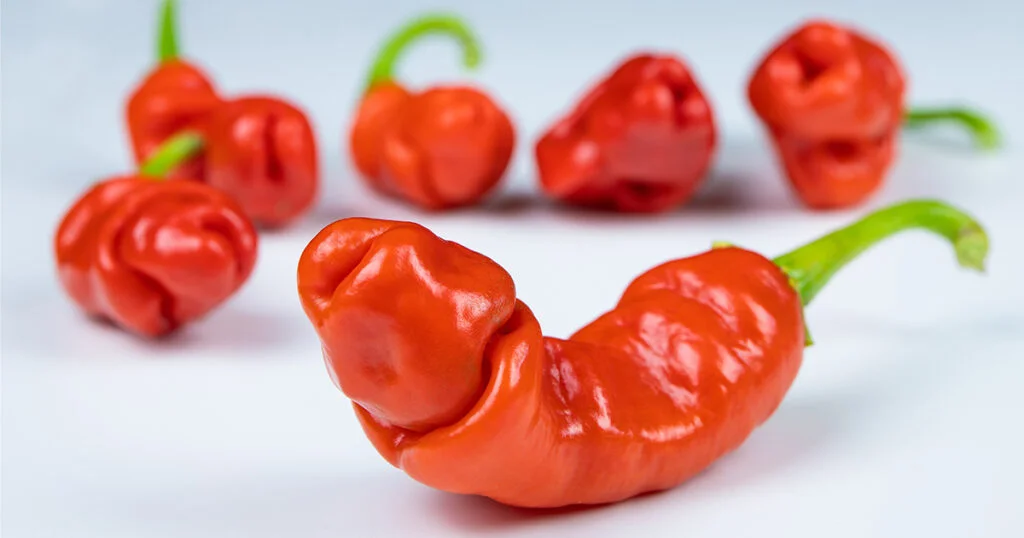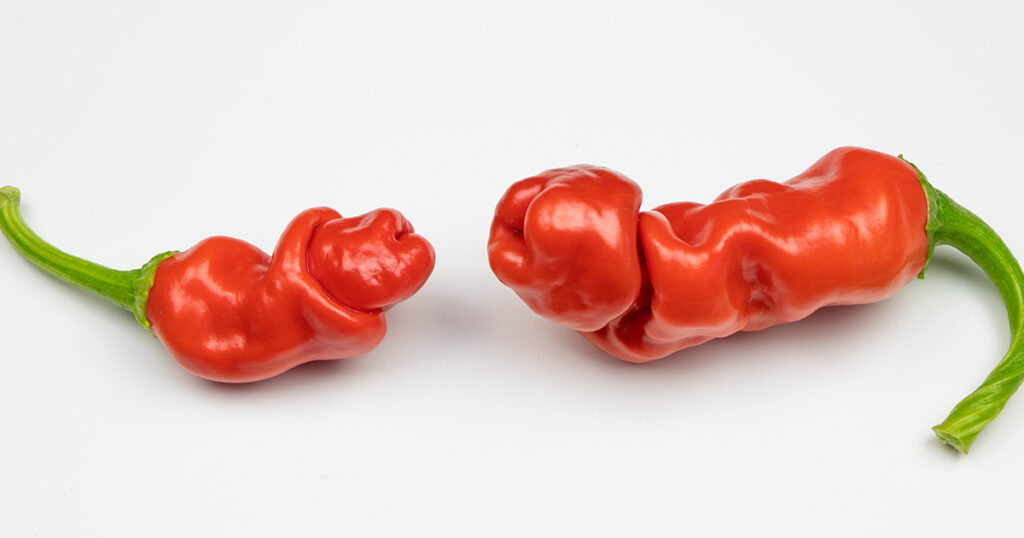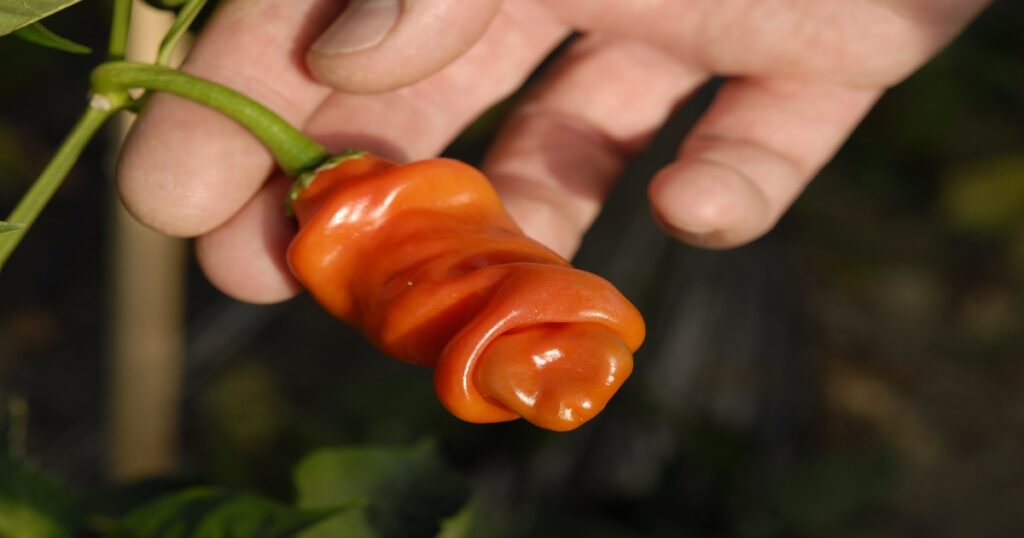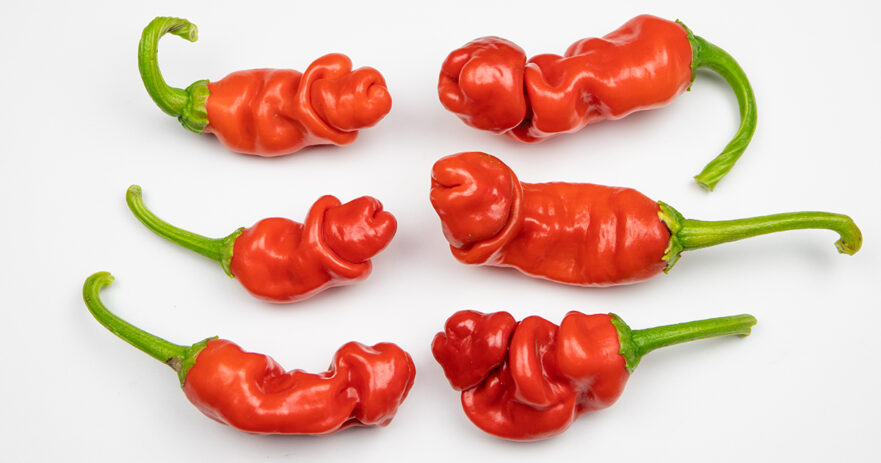In this article about peter pepper:
🗺️ Origin and history | 🌶️ Uses | ✨ Appearance and taste | 🌶️ Types | 🧑🌾 Growing – gardening | 👨🍳 Cooking – recipes | 🛒 Where to buy | 🫙 How to store | 👨⚕️ Health benefits | 🌶️ Alternatives and substitutes | ❓ Frequently asked questions
What is peter pepper?
Peter peppers have an unusually unique shape which has given them their humorous name. Like many other peppers, they are bright red when fully ripe and have a medium to hot heat level. Some nicknames of peter peppers include the “penis pepper” or “chili phallus” as their matured shape leads to chuckles at their sight.
Despite their interesting shape, the flavor and heat of peter peppers lend them to many dishes. Offering a unique addition of flavor, they are incorporated into global cuisines, whether in spicy sauces, salsas, or more. In addition, they increase the kick and provide a pop of color.
| Peter pepper | |
| SHU | 10,000 - 23,000 |
| Median SHU | 16,500 |
| Flavor | Bright, vegetable, sweet with a moderate to hot heat |
| Species | Capsicum annuum |
| Origin | United States |
| Uses | Pickling, salsas, sauces, etc. |
Are peter peppers spicy? How hot are they?
Peter pepper scoville: 10,000 to 23,000 SHU
Known for their moderate to high heat levels, peter peppers are often used in dishes that require a kick of spice. With a Scoville heat rating ranging from 10,000 to 23,000 units, these peppers are hotter than other milder varieties, such as banana or poblano peppers, though milder than many other peppers.
Peter peppers’ heat level lands greatly above jalapeño peppers (which range from 2,500 to 8,000 Scoville units). While peter peppers generally provide this more intense heat, it’s important to recognize that the spiciness can vary from pepper to pepper due to their differing maturity levels and conditions for growth. Ripe peter peppers are typically hotter than less mature peppers with a milder kick of heat. In conjunction with their heat, the peppers also add a unique flavor to any dish that pepper-lovers will appreciate.
🗺️ ORIGIN AND HISTORY
Where do peter peppers come from?
It’s not known exactly where peter peppers originated from, although most believe them to be native to Texas and Louisiana in the United States. Local communities appreciated peter peppers for quite some time before they spread throughout the rest of the world. In the last century, the peppers have become popular with American pepper enthusiasts’ help.
In comparison to other peppers, their cultivation and growth are still considered rare, though it has grown across the globe as seeds are more readily available from private and commercial parties. Currently, peter peppers are often grown in parts of Mexico and in many home gardens. In addition, the southern United States still fondly uses peter peppers in their culinary dishes and gardening beds.
🌶️ USES
What are peter peppers good for? How can they be used?
Included in many dishes, peter peppers add heat and color to delight many consumers. With a deep flavor and bright color, they are used to enrich many recipes. And while they are most often loved in dishes that require a bit of a kick, visually, these peppers give a nice color that any eye will appreciate.
Because of their versatility, peter peppers are incorporated into many sauces, dips, and spreads. To create a tasty salsa, just combine them with tomatoes, onions, garlic, and your favorite seasonings.
Combine the chopped peppers with onions, vinegar, sugar, and spices for a yummy peter pepper relish to use on top of burgers, hot dogs, or grilled dishes.
Another unique use takes peter peppers and blends them with cream cheese or sour cream to create a creamy dip.
Incorporate peter peppers into fajitas by sautéing them with onions and bell peppers, or add them into a stir-fry to give a spicy kick.
Peter peppers can also be added to cooked or baked dishes, such as casseroles, pastas, or stews, to enhance the flavor of any meal. These chilies give a bold heat and slightly fruity tang that blends well with most other flavors.
✨ APPEARANCE AND TASTE

What do peter peppers look like?
Peter peppers are distinctive chilies that would be difficult to mix up with any variety. Typically 3 to 4 inches in length and 1 to 1.5 inches in diameter, their general size is similar to other peppers. However, their shape diverges from other peppers as it resembles a penis, always eliciting grins and giggles. The peter pepper receives its name based on this unique appearance. These peppers change in color throughout their lifespan, ranging from green at first to vibrant red when fully mature. Their skin is glossy, thin, and smooth. The peppers’ insides are hollow and hold small, edible seeds.
How do peter peppers taste?
Flavorful peter peppers combine heat and a subtle, sweet flavor. Moderately hot, they range from 10,000 to 23,000 on the Scoville heat scale, giving dishes a noticeable kick of spice. However, unlike other peppers, their heat is not entirely overwhelming.
If eaten raw, peter peppers will be crisp and give an initial slightly sweet and earthy taste, quickly followed by a kick of heat. When matured and deep red, their flavor will become a bit sweeter than less mature peppers.
🌶️ TYPES
What are the different types of peter peppers?
Peter peppers can be enjoyed in many forms and colors. We will delve into the four most popular varieties: red, orange, purple, and yellow peppers.
Known for its deep red color, the red peter pepper is perhaps the most popular variety among chili lovers. Giving a more intense spicy kick to dishes incorporating these peppers, it adds a unique flavor and heat without overwhelming the dish.
Orange peter peppers, with a vibrant orange hue, also lend a similar heat as the red variety. The spice and beautiful color add depth to any meal.
The rarest, the purple peter pepper, captivates the eye with its unique purple color. With a milder spice level, these are opted for when a less distinct kick of heat is desired. They are incorporated into various dishes to provide a mild heat and tasty flavor.
Lastly, yellow peter peppers are recognized for a similar spice and slightly tangy flavor. These are hotter than the red variant and well-loved by consumers who enjoy a higher heat level in their meals. With their vivid coloring and intense flavor, yellow peppers are often used in salsas, sauces, and marinades.
🧑🌾 GROWING – GARDENING

How to grow peter peppers?
Peter peppers are often grown and cultivated in home gardens. Flourishing in environments with great sunlight and warm temperatures is perfect for growing in places that maintain a long, hot growing period. Whether grown in pots or directly in the soil, they require regular watering and well-draining soil for optimal growth. Fertilization throughout cultivation can benefit the plants for an even more abundant result.
When to pick peter peppers?
Fully mature peter peppers take around 80 to 100 days to come into their own. The timing is crucial with these peppers, so ideally, they will be harvested when they reach a vibrant red color and their unique shape can be seen. Take caution when handling them during the harvest because of their form and heat levels.
👨🍳 COOKING – RECIPES
Cooking / Recipe ideas for peter pepper
With a unique flavor, distinct shape, and moderate to mild heat, peter peppers intrigue many happy eaters. Their versatility allows them to be used in many ways, including grilling, salsas, in casseroles, and many more.
You can fry or air-fry peter peppers for a tasty and quickly created snack. Coat them in a crispy batter and toss them into the deep-fryer or air-fryer to perfect them with a crunchy layer outside and a softer interior. Alternatively, roasting these peppers will caramelize their sugars, giving them sharper heat. An excellent side dish once caramelized, you can add a bit of olive oil and sprinkle salt and pepper on top to enhance their taste.
A peter pepper chili is a classic dish to truly show off these peppers’ heat and distinct flavor. They can also be incorporated into casseroles, pastas, and stews to enjoy their heat and flavor. Also, many sauces and salsas benefit from peter peppers’ unique taste and pop of color.
🛒 WHERE TO BUY
Where can I buy peter peppers?
While peter peppers are not as commonly found in grocery stores as other popular peppers. Thankfully, there are a few places where you can purchase them, including specialized food stores, local farmer’s markets, or online grocery retailers. Seek places online specializing in exotic, fresh produce for the best results. When purchasing fresh peter peppers, locate the ones that are bright in color, firm, and maintain smooth skin, free of dark spots or blemishes.
Where can I buy peter pepper plants?
To grow your own peter peppers, purchasing young plants is the best way to start. Garden centers or nurseries sometimes carry peter pepper plants during the growing season. If you cannot locate them at a local retailer, look into online sources specializing in shipping live plants. The live plants may be shipped directly to your door for you to transfer them into your garden.
Where can I buy peter pepper seeds?
Many gardening enthusiasts enjoy cultivating straight from seeds. Similar to plants, they can be found in garden centers or nurseries. Peter pepper seeds can also be purchased from online retailers, though we encourage you to select a reputable seller to ensure the seeds are of the best quality to grow into healthy plants.
🫙 HOW TO STORE
How do I store peter peppers?
Fresh peter peppers can be preserved in the refrigerator for about two weeks at most. Just place them into a plastic bag or sealable container and store them in the refrigerator’s crisper drawer to optimally store them. This will help sustain their texture and flavor for an extended shelf life.
Can peter peppers be frozen?
Yes, freezing is a great option for storing peter peppers to enjoy over a lengthier period of time. To freeze them, simply clean the peppers and remove their stems and seeds. Then, arrange them in a single layer on a baking sheet and place the sheet in the freezer for a few hours. Check on the peppers, and if they are fully frozen, place them in a freezer-safe plastic bag or into an airtight container, placing them back in the freezer. Peter peppers can be stored for up to six months frozen. Then, when you want to use them in your next meal, take them out of the freezer to thaw them.
❤️🩹 HEALTH BENEFITS

Are peter peppers healthy?
With great nutritional content, peter peppers are an excellent addition to a well-balanced diet. They are low-calorie peppers, full of fiber, essential vitamins, and minerals. Peter peppers are high in vitamin C, which can enhance immune systems and aid overall health.
Capsaicin causes their heat level, which is known to help provide anti-inflammatory support to body.
Despite their many health benefits, peter peppers can cause digestive discomfort due to their spiciness. If eating these peppers causes discomfort, we encourage limiting their consumption or eliminating it entirely from your diet.
🔄 ALTERNATIVES AND SUBSTITUTES
What are suitable peter pepper alternatives?
With peter peppers’ distinct heat and flavor, multiple options are available for alternatives to fit your distinct preferences and needs.
Though milder, banana peppers may be a great alternative for those who enjoy the shape of peter peppers without the strong kick of heat. With a similar elongated shape, banana peppers give a milder and sweeter flavor, also a great option in salads, relishes, and more.
With a similar flavor profile but a milder heat, jalapeño peppers are a great substitution. While their shape is unlike a peter pepper, jalapeños offer an exceptionally similar taste to peters. Adaptable and versatile, jalapeños can be incorporated into the same recipes as peter peppers, including salsas, stir-fries, relishes, and more, with a subtler spice and familiar flavor.
Significantly spicier, habanero peppers are a solid alternative. They offer a higher heat level than peter peppers, so their fiery flavor would add a great kick of spice to your favorite dishes. However, because they are much hotter, it is recommended to use them more sparingly and taste the dish as you cook to ensure it does not become too spicy. Habaneros are most commonly found in hot sauces, salsas, or any recipe that utilizes significant heat.
How do you pronounce peter pepper?
The correct pronunciation of peter peppers is pee-ter pep-pers.
🙋 FREQUENTLY ASKED QUESTIONS
FAQ about peter peppers
Are peter peppers hot?
Peter peppers are often hot, ranging from moderate to hot heat levels. On the Scoville Heat Scale, they range from 10,000 to 23,000 heat units. This scale places them at a hotter heat level than jalapeños (ranging from 2,500 to 8,000 heat units), though less spicy than habaneros (reaching levels of 350,000 Scoville heat units).
Are peter peppers hot or sweet?
Predominantly hot, peter peppers also have a hint of sweetness in their taste, which can come as a surprise. This hot, sweet blend of flavors aids their versatility in various global cuisines. The heat increases the intensity of a dish, while the subtly sweet taste can easily enhance other flavors and balance some of the spice out.
What are other names for peter peppers?
As a distinctive chili pepper, peter peppers are well-known for their unusual shape, which lends to a few nicknames. These include the humorous titles of “penis pepper” and “chili phallus,” due to their phallic appearance.

